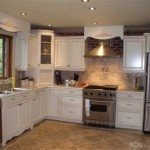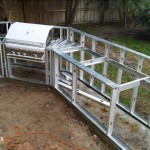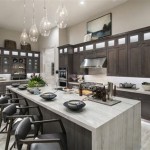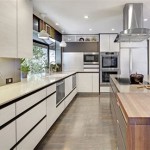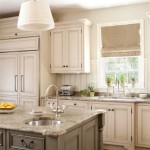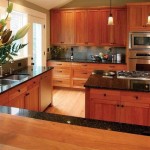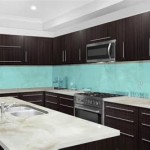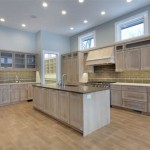Kitchen Lighting Ideas for Spaces Without Islands
Kitchen lighting is a crucial aspect of any well-designed home. It not only provides illumination for food preparation and other tasks but also contributes significantly to the overall ambiance and aesthetic appeal of the space. While kitchen islands often become a focal point for lighting design, many kitchens lack this architectural feature. This article will explore various kitchen lighting ideas suitable for kitchens without islands, focusing on effective strategies for providing adequate and stylish illumination.
Understanding the Importance of Layered Lighting
A well-lit kitchen relies on a layered approach, combining different types of lighting to achieve optimal functionality and visual interest. These layers typically include ambient, task, and accent lighting. Ambient lighting provides overall illumination, task lighting focuses on specific work areas, and accent lighting highlights architectural features or decorative elements. The absence of an island necessitates a strategic approach to distribute these lighting layers effectively.
Ambient lighting, also known as general lighting, aims to evenly illuminate the entire kitchen. This can be achieved through various fixtures, including ceiling-mounted lights, recessed lighting, and pendant lights strategically placed throughout the space. The goal is to create a base level of illumination that allows for comfortable movement and basic tasks. In the absence of an island, careful consideration should be given to the placement of these fixtures to eliminate shadows and ensure consistent light distribution.
Task lighting is critical for areas where food preparation and other activities take place. Undercabinet lighting is a common and highly effective solution for illuminating countertops. These lights provide direct, focused illumination for chopping, mixing, and other kitchen tasks. Pendant lights can also serve as task lighting if they are strategically positioned above specific work areas, such as a peninsula or a designated cutting board zone on the countertop. Good task lighting reduces eye strain and enhances safety while working in the kitchen.
Accent lighting adds visual interest and highlights specific features within the kitchen. This can include spotlights on artwork, decorative sconces on walls, or strategically placed lights that illuminate open shelving or glass-front cabinets. Accent lighting adds depth and dimension to the space, creating a more inviting and visually appealing environment. In kitchens without islands, accent lighting can be particularly useful for drawing attention to specific areas and creating a sense of visual balance.
Effective Lighting Fixtures for Island-Free Kitchens
The selection of appropriate lighting fixtures is paramount in achieving optimal illumination in island-free kitchens. Various options are available, each with its own unique characteristics and benefits. A careful assessment of the kitchen's size, layout, and style will guide the selection process.
Recessed lighting is a versatile and widely used option for ambient lighting. These fixtures are installed directly into the ceiling, providing a clean and unobtrusive source of illumination. Recessed lighting can be strategically placed throughout the kitchen to create even light distribution. Dimmable recessed lights offer added flexibility, allowing for adjustment of light levels to suit different activities and moods. The use of LED recessed lights is recommended for energy efficiency and longevity.
Ceiling-mounted fixtures, such as flush mount or semi-flush mount lights, offer another option for ambient lighting. These fixtures are mounted directly to the ceiling, providing a more prominent visual presence than recessed lights. Flush mount lights are ideal for kitchens with low ceilings, while semi-flush mount lights offer a bit more decorative flair. The style and finish of these fixtures should complement the overall aesthetic of the kitchen.
Pendant lights can be used effectively in kitchens without islands, especially when positioned above specific work areas or a peninsula. Single pendant lights or clusters of pendant lights can provide focused illumination for tasks such as food preparation or serving. The height of the pendant lights should be carefully considered to avoid obstructing views or creating glare. The style of the pendant lights should complement the overall design of the kitchen, adding a touch of personality and visual interest.
Undercabinet lighting is essential for providing task lighting on countertops. LED strip lights or puck lights are common choices for undercabinet illumination. These lights are typically mounted underneath the upper cabinets, providing direct, focused light on the work surface below. Undercabinet lighting enhances visibility and safety while preparing food, making it an indispensable element in any well-lit kitchen. Consider using warm white LEDs for a more inviting and pleasant illumination.
Track lighting offers a flexible and adaptable lighting solution. Track lights consist of a track mounted to the ceiling, with multiple adjustable light heads that can be positioned to illuminate specific areas. Track lighting is particularly useful for highlighting artwork, open shelving, or other architectural features. The adjustable nature of track lighting allows for customization and adaptation as needed. Track lighting can also be used to provide both ambient and task lighting, depending on the type of light heads used.
Strategic Lighting Placement and Control
The effectiveness of kitchen lighting depends not only on the type of fixtures but also on their strategic placement and control. Proper placement ensures adequate illumination of all work areas and minimizes shadows. Effective control systems allow for adjustment of light levels to suit different activities and create the desired ambiance.
When placing recessed lighting, it is important to consider the size and shape of the kitchen. A grid pattern is often used to ensure even distribution of light. Lights should be positioned to avoid casting shadows on countertops or other work surfaces. The distance between recessed lights should be carefully calculated to provide adequate overlap of light beams. Dimmers are highly recommended for recessed lighting, allowing for adjustment of light levels as needed.
The placement of pendant lights should be carefully considered to avoid obstructing views or creating glare. The height of the pendant lights should be adjusted to provide adequate illumination without being too close to the countertop. Pendants should be centered above the specific area they are intended to illuminate. Multiple pendant lights can be used to create a focal point and provide more balanced illumination.
Undercabinet lighting should be positioned as close to the front edge of the upper cabinets as possible to maximize illumination of the countertop. LED strip lights can be cut to length to fit the specific dimensions of each cabinet. Puck lights should be evenly spaced to provide consistent light coverage. Consider using undercabinet lights with built-in dimmers or motion sensors for added convenience and energy efficiency.
The use of light switches and dimmers is essential for controlling kitchen lighting. Multiple switches allow for independent control of different lighting zones, such as ambient, task, and accent lighting. Dimmers provide the ability to adjust light levels to suit different activities and create the desired ambiance. Smart lighting systems offer even greater control, allowing for remote control and automated scheduling of lights. Properly planned lighting controls enhance convenience and energy efficiency.
Color temperature is an often overlooked aspect of kitchen lighting. The color temperature of a light source is measured in Kelvin (K) and describes the warmth or coolness of the light. Warmer light sources (2700K-3000K) create a cozy and inviting atmosphere, while cooler light sources (4000K-5000K) provide a brighter and more energetic feel. For kitchens, a color temperature of around 3000K-3500K is often recommended, striking a balance between warmth and brightness. It is important to maintain consistent color temperature throughout the kitchen to avoid a jarring or inconsistent lighting scheme.

7 No Island Kitchen Lighting Ideas

The 25 Best No Island Kitchen Lighting Ideas Lightopia

The 25 Best No Island Kitchen Lighting Ideas Lightopia

The 25 Best No Island Kitchen Lighting Ideas Lightopia

The 25 Best No Island Kitchen Lighting Ideas Lightopia

The 25 Best No Island Kitchen Lighting Ideas Lightopia

The 25 Best No Island Kitchen Lighting Ideas Lightopia

The 25 Best No Island Kitchen Lighting Ideas Lightopia

7 No Island Kitchen Lighting Ideas Diannedecor Com

Small Kitchen Lighting Ideas That Make It Seem Bigger Flip The Switch
Related Posts

